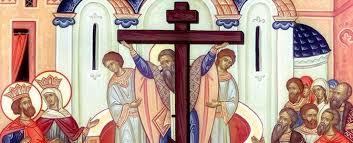The universe, including our planetary and human worlds, were made on the model of the Holy Cross. Therefore, by meditating on those worlds, we can find the truths of the faith wherever we open our eyes. The essence of this is that life involves suffering, which can be redeemed through the grace of God, who can bring us to eternal life. This is the message of the Holy Cross as a type. If ever a person wanted to understand how the ancient Semitic concept of typology is different from the Western concept, then St Ephrem’s meditations on the Holy Cross would be an ideal place to start.
St Ephrem, who died in 373, probably while St Maroun was in middle age, was a deacon in the Church at Edessa and Nisibis. The area is in modern south-east Turkey, but it used to be part of the Syriac cultural world. I shall be considering only numbers 17 and 18 of the 87 Hymns on Faith.
We can start with number 17, where in verse 11, St Ephrem writes:
Son of the Creator, son of the carpenter!
Since when he created, he created everything in the symbol of the cross.
Even the house of Joseph the carpenter
Now meditates on the Cross every day.
There are many interesting aspects here, and I will accept Jeffrey Wickes’ translation, although I humbly think it could be nuanced. But I will mention just five matters:
- The biblical text at the base of this is the so-called Prologue to the Gospel of St John: “In the beginning was the Word, and the Word was with God, and the Word was God. He was in the beginning with God. All things were made through Him, and without Him nothing was made that was made” (John 1:1-3). What St Ephrem is saying is that when things made, they were made according to the Cross.
- The word translated as “symbol” here, rō.zō, is a Persian loan word, and also has the meaning of “type.” To say that something is built according to a type, that is, a template or a model, makes much more sense than saying it is based on a symbol.
- St Ephrem brings together two facts which we rarely connect: that Our Lord was the Son of the Creator, and that He was the son of a carpenter. In other words, it was no coincidence that St Joseph was a carpenter, and that fact goes to show how the Incarnation was the incarnation of the Logos through whom the world was made, and this begins to add a new, perhaps more mystical dimension to the life-giving death and resurrection of the Lord. He through whom the world was made gave up His life and took it back up again so that the world could be revived with Him. Our Lord instituted a renewed creation.
- Although Wickes’ says that the house of Joseph means the Jews, I am not so sure. I think that in this context it means us: the Christians.
- Note that St Ephrem says that the activity which allows us to see the Cross in nature is meditation, in Syriac h.mas. I think of it like this, by meditation St Ephrem means something like “the silence of deep prayer.” Therefore, I respectfully disagree with Wickes’ comment that: “through one’s use of created materials, one is inevitably drawn to contemplate the Creator” (147). It is not just “use,” it is “meditation.”
Then, we come to Hymn 18 verse 2, where St Ephrem wrote that a bird passes through three stages: from the womb to the egg, from the egg to the nest, and from the nest into the air, so that: “when it has matured and has flown in the air, it stretches out its wings in the form of the Cross.” There is a tremendous amount of profound material here, but perhaps the climax is in verse 5:
When the spirit suffers, it is entirely inscribed by the Father.
When the soul suffers, it is entirely mingled with the Son.
When the body confesses and is burned,
It shares entirely in the Holy Spirit.
Therefore, just like a bird, which passes through three stages, so too does the human soul. We are created by the Father, as we suffer in life, we participate in the work of the Son (for He too suffered), and when we leave this world, we are joined with the Holy Spirit. This relates the Cross to threefold processes (an important topic in the spiritual psychology). But we do not need to go into that in an abstract way. What St Ephrem is saying is that to suffer and to overcome that suffering by being resurrected according to the promise of God, whose Only Son showed us the way, is to witness in our own souls to the type of the Cross.
To use the language of typology, the Holy Cross is our type, and the soul is its antetype. St Ephrem adds many more examples of this in Hymn 18. For example, when someone plants a seed in the earth, “a secret life proclaims your resurrection.” The grapes which hang from the vine, filled with the red juice, are like the blood of the Lord which was given on the Cross; and the rooster which spreads his wings when he crows at down both makes the sign of the Holy Cross with his wings, and awakens the sleeping just as the dead will be woken at the resurrection. He also applies this symbol to ships, sails, the sea, and the spirit or wind which moves the ship.
Whatever one thinks of the value of St Ephrem’s treatment of this topic, one thing is clear: the Semitic concept of typology is far wider and more extensive than simply finding the New Testament in the Old Testament.

Thank you Father. St Ephrem is truly the “Harp of the Holy Spirit”!